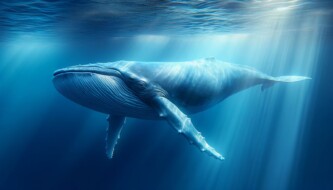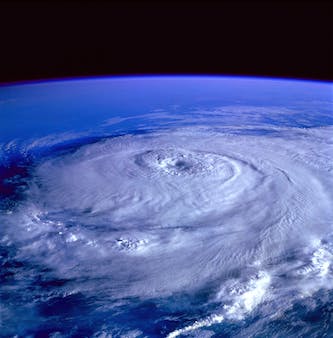Blue whales, the largest animals on Earth, have returned to a part of the Indian Ocean where they were previously wiped out by whaling. Researchers and filmmakers in the Seychelles captured footage of the whales in 2020 and 2021, suggesting that they may be breeding in the region. This is a significant conservation win, as the blue whale population was decimated by the Soviet whaling fleet in the 1960s. Blue whales are still endangered, with their numbers being only a fraction of what they once were. However, the discovery of their presence in the Seychelles is incredibly exciting.
The researchers used underwater audio recording to study the blue whales. They fixed a “sound trap” to the seabed near the Seychelles and left it in place for a year, recording 15 minutes of every hour, every day. Although they did not hear the blue whales during their expedition, analysis of the recordings revealed that the whales were present and communicating during certain months, particularly March and April. The researchers believe that the Seychelles could be an important breeding or nursery area for the blue whales.
The blue whale’s song is so deep and low-frequency that it is beyond the range of human hearing. However, researchers can detect the higher frequency sounds, known as harmonics, that accompany the whale’s song. These harmonics create a low, deep, and consistent pulse that is the loudest sustained sound in the animal kingdom. Blue whales use these sounds to communicate over long distances in the water.
Conservation scientists are interested in understanding the importance of the Seychelles for blue whales. The area around the islands has been protected, and the Seychelles government has committed to protecting 30% of its national waters. This is crucial for safeguarding important areas for blue whales and other marine species. Noise pollution from human activities is a major concern, as it can disrupt the communication and behavior of blue whales. The Seychelles, with its relatively low ship traffic, could provide a safe and quiet haven for these magnificent creatures.
Original news source: Blue whales: Ocean giants return to ‘safe’ tropical haven (BBC)
Listen
Slow
Normal
Fast
Group or Classroom Activities
Warm-up Activities:
– Charades
Instructions: Divide the class into small groups. Give each group a slip of paper with a word or phrase related to the article (e.g. blue whale, whaling, Seychelles). One person from each group will act out the word or phrase without speaking, and the rest of the group has to guess what it is.
– News Summary
Instructions: Ask the students to read the article individually. After they have finished, have them write a summary of the article in their own words. Then, divide the class into pairs and have them share and compare their summaries. Finally, ask a few pairs to share their summaries with the whole class.
– Opinion Poll
Instructions: Write a question related to the article on the board (e.g. “Do you think the discovery of blue whales in the Seychelles is a significant conservation win?”). Ask each student to write down their opinion and a brief explanation. Then, have them pair up and share their opinions and explanations. After that, conduct a class discussion where students can share their opinions and debate the topic.
– Vocabulary Pictionary
Instructions: Divide the class into pairs. Give each pair a list of vocabulary words from the article (e.g. whaling, decimated, harmonics). One person from each pair will choose a word and draw a picture to represent it, while the other person has to guess the word. Set a time limit for each round and rotate roles after each round. The pair with the most correct guesses wins.
– Two Truths and a Lie
Instructions: Ask each student to come up with two true statements and one false statement related to the article. Then, divide the class into small groups and have them take turns sharing their statements. The other group members have to guess which statement is the lie. This activity encourages students to use their comprehension skills and think critically about the content of the article.
Comprehension Questions:
1. What evidence suggests that blue whales may be breeding in the Seychelles?
2. How did the researchers study the blue whales in the Seychelles?
3. What months did the analysis of the recordings reveal that the blue whales were present and communicating?
4. Why is the blue whale’s song beyond the range of human hearing?
5. What do blue whales use their sounds for?
6. Why are conservation scientists interested in understanding the importance of the Seychelles for blue whales?
7. What is a major concern for blue whales in terms of human activities?
8. How could the Seychelles provide a safe and quiet haven for blue whales?
Go to answers ⇩
Listen and Fill in the Gaps:
Blue whales, the largest animals on Earth, have returned to a part of the (1)______ Ocean where they were previously (2)______ out by whaling. Researchers and filmmakers in the Seychelles captured footage of the whales in 2020 and 2021, suggesting that they may be (3)______ in the region. This is a significant conservation win, as the blue whale population was decimated by the Soviet whaling fleet in the 1960s. Blue whales are still endangered, with their (4)______ being only a fraction of what they once were. However, the discovery of their presence in the Seychelles is incredibly exciting.
The (5)______ used underwater audio recording to study the blue (6)______. They fixed a “sound trap” to the seabed near the Seychelles and left it in place for a year, recording 15 minutes of every hour, every day. Although they did not hear the blue whales during their expedition, analysis of the recordings (7)______ that the whales were present and communicating during certain (8)______, particularly March and April. The researchers believe that the Seychelles could be an (9)______ breeding or nursery area for the blue whales.
The blue whale’s song is so deep and low-frequency that it is beyond the range of human hearing. However, researchers can detect the higher frequency (10)______, known as harmonics, that (11)______ the whale’s song. These harmonics create a low, deep, and consistent pulse that is the (12)______ sustained sound in the animal kingdom. Blue whales use these sounds to communicate over long distances in the water.
Conservation scientists are interested in understanding the importance of the Seychelles for blue whales. The area around the islands has been protected, and the Seychelles government has (13)______ to protecting 30% of its national waters. This is crucial for safeguarding important areas for blue whales and other (14)______ species. Noise pollution from human activities is a (15)______ concern, as it can disrupt the communication and behavior of blue whales. The Seychelles, with its relatively low ship traffic, could (16)______ a safe and quiet haven for these magnificent creatures.
Go to answers ⇩
Discussion Questions:
Students can ask a partner these questions, or discuss them as a group.
1. What is your opinion on the return of blue whales to the Seychelles?
2. How would you feel if you had the opportunity to see a blue whale in person?
3. Do you think the protection of the Seychelles’ national waters is an effective way to conserve blue whales? Why or why not?
4. Have you ever seen a documentary or film about blue whales? If so, what did you learn from it?
5. What do you think is the significance of the discovery that blue whales may be breeding in the Seychelles?
6. How do you think noise pollution from human activities can affect the communication and behavior of blue whales?
7. Do you believe that the Seychelles can provide a safe and quiet haven for blue whales? Why or why not?
8. What measures do you think can be taken to further protect blue whales and their breeding areas?
9. Have you ever been on a boat or ship in the ocean? How do you think this experience compares to being in the presence of a blue whale?
10. How do you think the presence of blue whales in the Seychelles can impact eco-tourism in the region?
11. Have you ever heard any sounds from marine animals in the ocean? If so, what were they like?
12. Do you think it is important for governments to commit to protecting a certain percentage of their national waters? Why or why not?
13. What other endangered species do you think can benefit from the protection of marine areas?
14. How do you think the discovery of blue whales breeding in the Seychelles can impact scientific research and understanding of these animals?
15. Do you like watching nature documentaries? If so, what is your favorite documentary about marine life? Why?
Individual Activities
Vocabulary Meanings:
Match each word to its meaning.
Words:
1. blue
2. whales
3. Seychelles
4. breeding
5. population
6. researchers
7. communication
8. conservation
Meanings:
(a) The protection and preservation of the environment
(b) The total number of a particular species
(c) The largest animals on Earth
(d) The act of exchanging information or ideas
(e) A group of islands in the Indian Ocean
(f) The colour of the sky
(g) People who study and investigate a subject
(h) The process of producing offspring
Go to answers ⇩
Multiple Choice Questions:
1. What is the main topic of the article?
(a) The dangers of whaling
(b) Blue whales returning to the Seychelles
(c) The size of blue whales
(d) Underwater audio recording techniques
2. How were the blue whales studied in the Seychelles?
(a) Using underwater audio recording
(b) Using satellite tracking devices
(c) Using visual observations
(d) Using DNA analysis
3. What is the significance of the blue whales being present in the Seychelles?
(a) It indicates a decrease in their population
(b) It shows the impact of noise pollution on their behavior
(c) It suggests they may be breeding in the region
(d) It highlights the dangers of whaling
4. How did the researchers detect the presence of blue whales?
(a) By visually observing the whales in the water
(b) By analyzing the recordings from the underwater audio trap
(c) By tracking the whales using satellite technology
(d) By listening for their low-frequency songs
5. What is the purpose of the blue whale’s song?
(a) To scare away predators
(b) To attract mates
(c) To navigate in the water
(d) To communicate over long distances
6. Why is protecting the Seychelles important for blue whales?
(a) It prevents noise pollution from human activities
(b) It ensures their breeding and nursery areas are safeguarded
(c) It helps increase their population numbers
(d) It provides a safe and quiet haven for them
7. What is a major concern for blue whales in terms of human activities?
(a) Noise pollution disrupting their communication and behavior
(b) Overfishing depleting their food sources
(c) Pollution from plastic waste harming their health
(d) Climate change affecting their habitats
8. What is the current status of the blue whale population?
(a) Stable and thriving in all regions
(b) Extinct in the Indian Ocean
(c) Endangered with only a fraction of their previous numbers
(d) Recovering from previous whaling activities
Go to answers ⇩
True or False Questions:
1. Analysis of the recordings revealed that blue whales were absent and silent during certain months, particularly March and April.
2. The presence of blue whales in the Seychelles suggests they may not be breeding in the region.
3. Blue whales are still endangered, with their numbers being only a fraction of what they once were.
4. The Seychelles could be an important breeding or nursery area for blue whales.
5. The blue whale population was protected by the Soviet whaling fleet in the 1960s.
6. Blue whales, the smallest animals on Earth, have returned to the Indian Ocean after being wiped out by whaling.
7. Underwater audio recordings were used to study the blue whales in the Seychelles.
8. Researchers and filmmakers in the Seychelles captured footage of blue whales in 2020 and 2021.
Go to answers ⇩
Write a Summary:
Write a summary of this news article in two sentences.
Check your writing now with the best free AI for English writing!
Writing Questions:
Answer the following questions. Write as much as you can for each answer.
Check your answers with our free English writing assistant!
1. What is the significance of the blue whales returning to the Indian Ocean?
2. How did the researchers study the blue whales in the Seychelles?
3. What is the purpose of the blue whale’s song?
4. Why is the protection of the Seychelles important for blue whales?
5. What is the potential impact of noise pollution on blue whales?
Answers
Comprehension Question Answers:
1. The evidence that suggests blue whales may be breeding in the Seychelles is the footage captured by researchers and filmmakers in 2020 and 2021, indicating the presence of the whales in the region.
2. The researchers studied the blue whales in the Seychelles by using underwater audio recording. They fixed a “sound trap” to the seabed near the Seychelles and recorded 15 minutes of every hour, every day for a year.
3. The analysis of the recordings revealed that the blue whales were present and communicating during certain months, particularly March and April.
4. The blue whale’s song is beyond the range of human hearing because it is so deep and low-frequency.
5. Blue whales use their sounds to communicate over long distances in the water.
6. Conservation scientists are interested in understanding the importance of the Seychelles for blue whales to ensure the protection of important breeding or nursery areas for these endangered animals.
7. Noise pollution from human activities is a major concern for blue whales as it can disrupt their communication and behavior.
8. The Seychelles could provide a safe and quiet haven for blue whales due to its relatively low ship traffic, which reduces the risk of noise pollution and disturbance to the whales.
Go back to questions ⇧
Listen and Fill in the Gaps Answers:
(1) Indian
(2) wiped
(3) breeding
(4) numbers
(5) researchers
(6) whales
(7) revealed
(8) months
(9) important
(10) sounds
(11) accompany
(12) loudest
(13) committed
(14) marine
(15) major
(16) provide
Go back to questions ⇧
Vocabulary Meanings Answers:
1. blue
Answer: (f) The colour of the sky
2. whales
Answer: (c) The largest animals on Earth
3. Seychelles
Answer: (e) A group of islands in the Indian Ocean
4. breeding
Answer: (h) The process of producing offspring
5. population
Answer: (b) The total number of a particular species
6. researchers
Answer: (g) People who study and investigate a subject
7. communication
Answer: (d) The act of exchanging information or ideas
8. conservation
Answer: (a) The protection and preservation of the environment
Go back to questions ⇧
Multiple Choice Answers:
1. What is the main topic of the article?
Answer: (b) Blue whales returning to the Seychelles
2. How were the blue whales studied in the Seychelles?
Answer: (a) Using underwater audio recording
3. What is the significance of the blue whales being present in the Seychelles?
Answer: (c) It suggests they may be breeding in the region
4. How did the researchers detect the presence of blue whales?
Answer: (b) By analyzing the recordings from the underwater audio trap
5. What is the purpose of the blue whale’s song?
Answer: (d) To communicate over long distances
6. Why is protecting the Seychelles important for blue whales?
Answer: (d) It provides a safe and quiet haven for them
7. What is a major concern for blue whales in terms of human activities?
Answer: (a) Noise pollution disrupting their communication and behavior
8. What is the current status of the blue whale population?
Answer: (c) Endangered with only a fraction of their previous numbers
Go back to questions ⇧
True or False Answers:
1. Analysis of the recordings revealed that blue whales were absent and silent during certain months, particularly March and April. (Answer: False)
2. The presence of blue whales in the Seychelles suggests they may not be breeding in the region. (Answer: False)
3. Blue whales are still endangered, with their numbers being only a fraction of what they once were. (Answer: True)
4. The Seychelles could be an important breeding or nursery area for blue whales. (Answer: True)
5. The blue whale population was protected by the Soviet whaling fleet in the 1960s. (Answer: False)
6. Blue whales, the smallest animals on Earth, have returned to the Indian Ocean after being wiped out by whaling. (Answer: False)
7. Underwater audio recordings were used to study the blue whales in the Seychelles. (Answer: True)
8. Researchers and filmmakers in the Seychelles captured footage of blue whales in 2020 and 2021. (Answer: True)
Go back to questions ⇧













